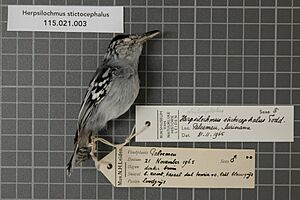Todd's antwren facts for kids
Quick facts for kids Todd's antwren |
|
|---|---|
 |
|
| Conservation status | |
| Scientific classification | |
| Genus: |
Herpsilochmus
|
| Species: |
stictocephalus
|
 |
|
Todd's antwren (Herpsilochmus stictocephalus) is a small bird that lives in the forests of South America. It's part of a bird family called "typical antbirds." You can find this bird in countries like Brazil, French Guiana, Guyana, Suriname, and Venezuela.
Contents
About Todd's Antwren
What Does Todd's Antwren Look Like?
Todd's antwren is about 10 to 11 centimeters (4 to 4.3 inches) long. It weighs around 8 to 9.5 grams (0.28 to 0.34 ounces).
Male antwrens have a black forehead with small white stripes. Their head and the back of their neck are black. They have a long white stripe above their eye and a black stripe behind it. Their back is light gray with small black spots. They also have white-edged feathers on their shoulders and a white patch between them.
Their wings are black with white tips on some feathers and white edges on others. Their tail is black with white tips and spots. The middle tail feathers have a white streak. Their throat is white, and their belly is light gray.
Female antwrens look a bit different. Their forehead has a light brown color. Their black head has white spots. Their chest and sides are light brown. Their wings and tail look like the male's.
This bird looks very similar to the spot-tailed antwren. The main differences are the female's feathers and the bird's song.
Where Does Todd's Antwren Live?
Todd's antwren lives in eastern Venezuela, the Guianas (French Guiana, Guyana, Suriname), and northeastern Brazil.
It prefers to live in tall, humid evergreen forests. These are forests where trees stay green all year. It likes areas with rich soil. You won't usually find it in grassy forests or forests that flood often. It lives from sea level up to about 700 meters (2,300 feet) high.
How Does Todd's Antwren Behave?
Todd's antwren likely stays in the same area all year round. It doesn't seem to migrate.
What Does Todd's Antwren Eat?
Todd's antwren mainly eats arthropods, which are insects and spiders. It hunts for food alone, in pairs, or with its family. It often joins groups of different bird species that hunt together.
It usually looks for food high up in the trees, about 20 to 40 meters (66 to 130 feet) above the ground. It searches at the ends of leafy branches, in the tops of trees, and in tangled vines. It moves carefully and quickly. It usually catches prey by picking insects off leaves, stems, and vines while perched. It is not known to follow army ants.
Reproduction and Life Cycle
Scientists don't know much about how Todd's antwren reproduces or raises its young.
Vocalization
The song of Todd's antwren is a fast series of about 12 high-pitched notes. These notes go lower and slow down at the end. Its calls include a quick, downward-sounding "tup" and a short, vibrating "chit."
Its song is the easiest way to tell it apart from the spot-tailed antwren. Both birds are hard to see high up in the forest trees.
Is Todd's Antwren in Danger?
The IUCN (International Union for Conservation of Nature) says Todd's antwren is a species of "Least Concern." This means it's not currently in immediate danger of disappearing.
It lives across a large area. However, its population size is unknown and is thought to be getting smaller. No major threats have been found yet.
Even though it's not well-known, it's considered uncommon in the places it lives. Some protected areas are within its habitat. There are also large areas of untouched forest that seem safe for now. But, the bird is thought to be very sensitive to human activities that disturb its home.


